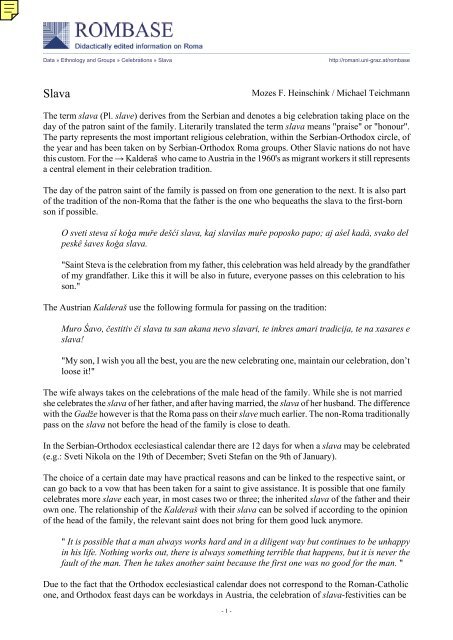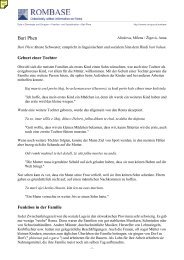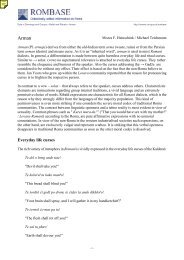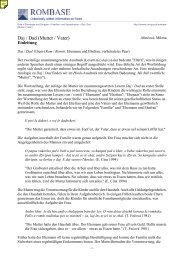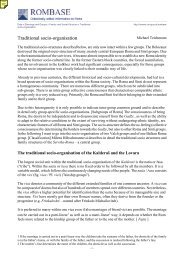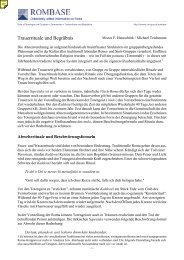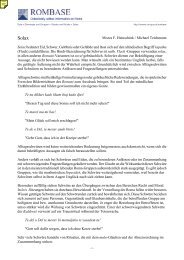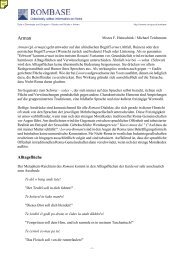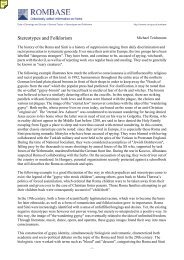Printable version
Printable version
Printable version
You also want an ePaper? Increase the reach of your titles
YUMPU automatically turns print PDFs into web optimized ePapers that Google loves.
Data » Ethnology and Groups » Celebrations » Slava<br />
Slava<br />
Mozes F. Heinschink / Michael Teichmann<br />
The term slava (Pl. slave) derives from the Serbian and denotes a big celebration taking place on the<br />
day of the patron saint of the family. Literarily translated the term slava means "praise" or "honour".<br />
The party represents the most important religious celebration, within the Serbian-Orthodox circle, of<br />
the year and has been taken on by Serbian-Orthodox Roma groups. Other Slavic nations do not have<br />
this custom. For the → Kalderaš who came to Austria in the 1960's as migrant workers it still represents<br />
a central element in their celebration tradition.<br />
The day of the patron saint of the family is passed on from one generation to the next. It is also part<br />
of the tradition of the non-Roma that the father is the one who bequeaths the slava to the first-born<br />
son if possible.<br />
O sveti steva sî koģa muře dešći slava, kaj slavilas muře poposko papo; aj aśel kadà, svako del<br />
peskê śaves koģa slava.<br />
"Saint Steva is the celebration from my father, this celebration was held already by the grandfather<br />
of my grandfather. Like this it will be also in future, everyone passes on this celebration to his<br />
son."<br />
The Austrian Kalderaš use the following formula for passing on the tradition:<br />
Muro Śavo, čestitiv či slava tu san akana nevo slavari, te inkres amari tradicija, te na xasares e<br />
slava!<br />
"My son, I wish you all the best, you are the new celebrating one, maintain our celebration, don’t<br />
loose it!"<br />
The wife always takes on the celebrations of the male head of the family. While she is not married<br />
she celebrates the slava of her father, and after having married, the slava of her husband. The difference<br />
with the Gadže however is that the Roma pass on their slave much earlier. The non-Roma traditionally<br />
pass on the slava not before the head of the family is close to death.<br />
In the Serbian-Orthodox ecclesiastical calendar there are 12 days for when a slava may be celebrated<br />
(e.g.: Sveti Nikola on the 19th of December; Sveti Stefan on the 9th of January).<br />
The choice of a certain date may have practical reasons and can be linked to the respective saint, or<br />
can go back to a vow that has been taken for a saint to give assistance. It is possible that one family<br />
celebrates more slave each year, in most cases two or three; the inherited slava of the father and their<br />
own one. The relationship of the Kalderaš with their slava can be solved if according to the opinion<br />
of the head of the family, the relevant saint does not bring for them good luck anymore.<br />
" It is possible that a man always works hard and in a diligent way but continues to be unhappy<br />
in his life. Nothing works out, there is always something terrible that happens, but it is never the<br />
fault of the man. Then he takes another saint because the first one was no good for the man. "<br />
Due to the fact that the Orthodox ecclesiastical calendar does not correspond to the Roman-Catholic<br />
one, and Orthodox feast days can be workdays in Austria, the celebration of slava-festivities can be<br />
- 1 -<br />
http://romani.uni-graz.at/rombase
Data » Ethnology and Groups » Celebrations » Slava<br />
quite difficult. The celebration, however, is obligatory. Even if it is impossible for the head of the<br />
family to celebrate with friends and relatives, he at least has to celebrate the religious ceremony.<br />
Sometimes in Vienna conditions, and shortage of space, do not allow celebrating the slava in an<br />
apartment. In this case advanced celebrations are held within the close family circle. Later on the real<br />
celebration is held in a restaurant. In many families, such an approach is accepted only as a<br />
less-than-ideal solution. Therefore, many Kalderaš-families prefer to spend the feast day in the original<br />
house of the family. They go to Serbia just for this day.<br />
Ceremony<br />
The slava of the Serbian-Orthodox Austrian Kalderaš is a three-day lasting party. On the second day<br />
of the party the slava takes place. In the morning of the first day the bread (Kalderaš: kolako / Serbian:<br />
"kolač") is consecrated either by the priest in the Serbian-Orthodox church or by the head of the family<br />
at home. The proceeding of the benediction is the same in this context. The kolako is cut on the<br />
underside and poured over with wine. When all the guests have gathered – festive clothes are a<br />
precondition – and have greeted the host by using traditional greetings (e.g. " Baxtali t’avel ći slava<br />
" / "Your ceremony be happy"), the religious ceremony is introduced by prayers. The now consecrated<br />
kolako is divided into three pieces and distributed to the present people together with cooked and<br />
sweetened corn (dživ). Kolako is a symbol for thanksgiving and for peace, dživ stands for the resurrection<br />
of Christ and for the birth of new life.<br />
This religious ceremony is held either on all of the three days or only on the second day. In no slava<br />
may there be missed neither incense (tumuja) nor a big consecrated (momeli) candle. In contrast to<br />
the Serbian non-Roma who blow out the candle with a drop of wine in the evening, the Kalderaš burn<br />
the candle until the last guest has left the house. When the candle is blown out the slava is considered<br />
as being over.<br />
Beside this important religious dimension the slava of the Kalderaš represents a party in order to foster<br />
social contacts within the extended family, in contrast to the religiously dominated Serbian slava.<br />
Similar to weddings (abjav /Pl.: abjava) and the special celebrations for a Kalderaš (paćiv/Pl.: paćiva)<br />
who has come from abroad the slava represents an opportunity to hold a good long celebration. Financial<br />
concerns must not be of any relevance in this context.<br />
The small number of feast days when a slava may be celebrated results in the fact that, for example,<br />
in Vienna numerous slave are celebrated on one day. Even if the head of the house has always to be<br />
present, his sons are also obliged to participate in the slave of family friends for at least a short time.<br />
This can be quite demanding considering that, in the context of each celebration, the guests have to<br />
eat and drink extensively.<br />
Sources<br />
Heinschink, Mozes F. (2002) Unpublished interview with Dragan Jevremović (Kalderaš).<br />
Wien.<br />
Heinschink, Mozes F. (2002) Unpublished interview with Fatma Heinschink (Sepečides).<br />
Wien.<br />
Phonogrammarchiv, Österreichische Akademie der Wissenschaften, B 39533 (= Sammlung<br />
Heinschink: KS 37) .<br />
- 2 -<br />
http://romani.uni-graz.at/rombase
Data » Ethnology and Groups » Celebrations » Slava<br />
References<br />
Andiel, Manuela (2001) Feste, Helden und Traditionen (Die Universität. Zeitung der Universität<br />
Wien – online [2001/09/02]).<br />
http://www.dieuniversitaet-online.at/modules.php&op=modload&name=News&file=article&sid=184,<br />
Wien.<br />
Cech, Petra / Fennesz-Juhasz, Christiane / Halwachs, Dieter W. / Heinschink, Mozes F. (eds.)<br />
(2001) Fern von uns im Traum ... / Te na dikhas sunende ... Märchen, Erzählungen und Lieder<br />
der Lovara, Klagenfurt.<br />
Fennesz-Juhasz, Christiane / Halwachs, Dieter W. / Heinschink, Mozes F. (1996) Sprache und<br />
Musik der österreichischen Roma. GLS 46, pp. 61-110.<br />
Fonseca, Isabell (1996) Begrabt mich aufrecht. Auf den Spuren der Zigeuner, München.<br />
Halwachs, Dieter W. / Menz, Florian (eds.) (1999) Die Sprache der Roma. Perspektiven der<br />
Romani-Forschung in Österreich im interdisziplinären und internationalen Kontext, Klagenfurt.<br />
Heinschink, Mozes F. / Hemetek, Ursula (eds.) (1994) Roma. Das unbekannte Volk. Schicksal<br />
und Kultur, Wien.<br />
Puhalo, Lev (1972) The Serbian Slava (Hermitage of the Holy Cross. Orthodox Life – online<br />
Version [22/1]). http://www.holycross-hermitage.com/pages/Orthodox_Life/serb_slava.htm .<br />
Schindegger, Florian (1997) Lebensweise von Zigeunern in Wien am Beispiel der Festtradition<br />
der Kalderaš. Wien.<br />
Vossen, Rüdiger (1983) Zigeuner. Roma, Sinti, Gitanos, Gypsies zwischen Verfolgung und<br />
Romantisierung, Hamburg.<br />
Mozes F. Heinschink / Michael Teichmann<br />
- 3 -<br />
http://romani.uni-graz.at/rombase<br />
September 2002 / Graz / Wien, Austria


